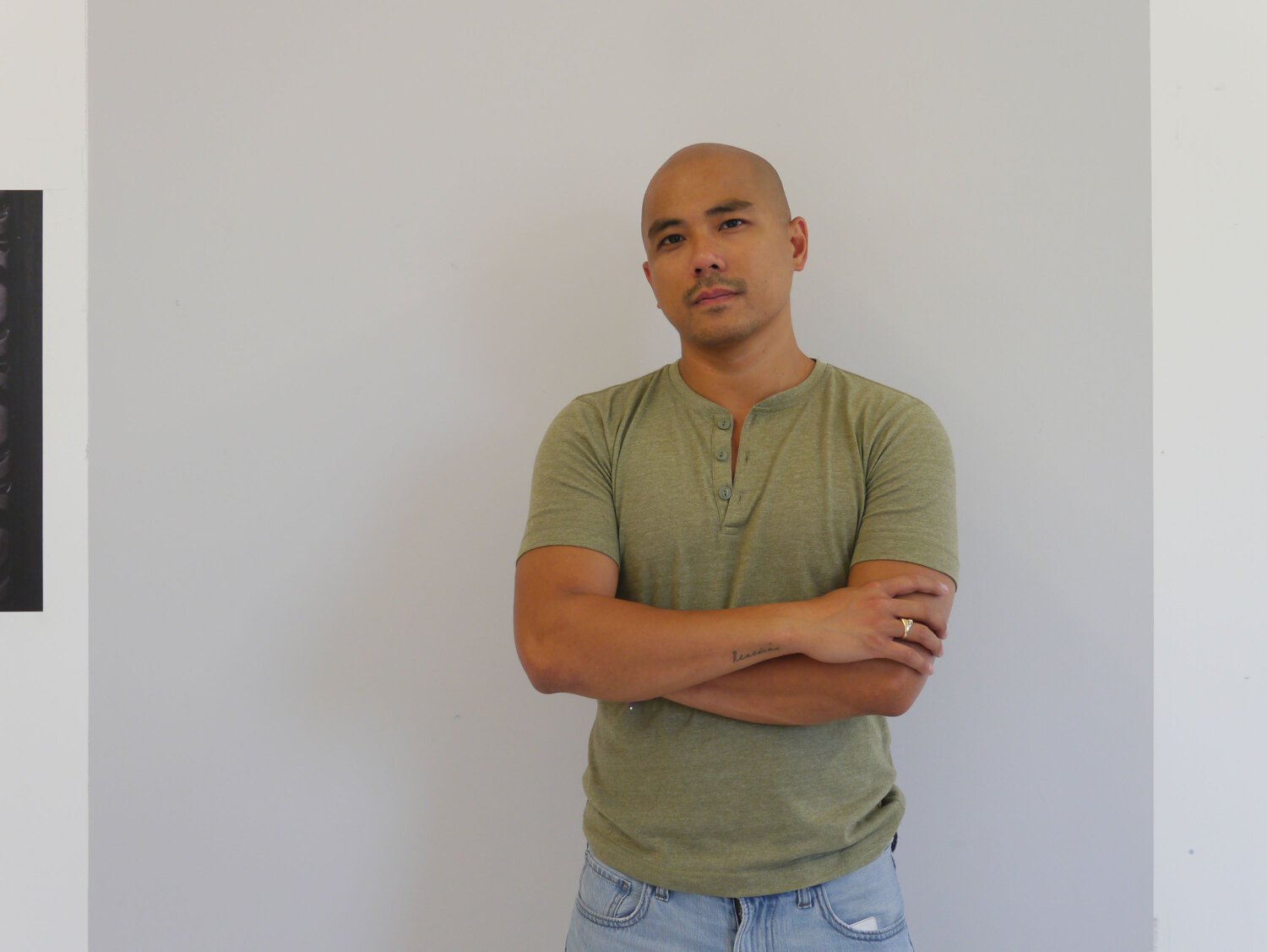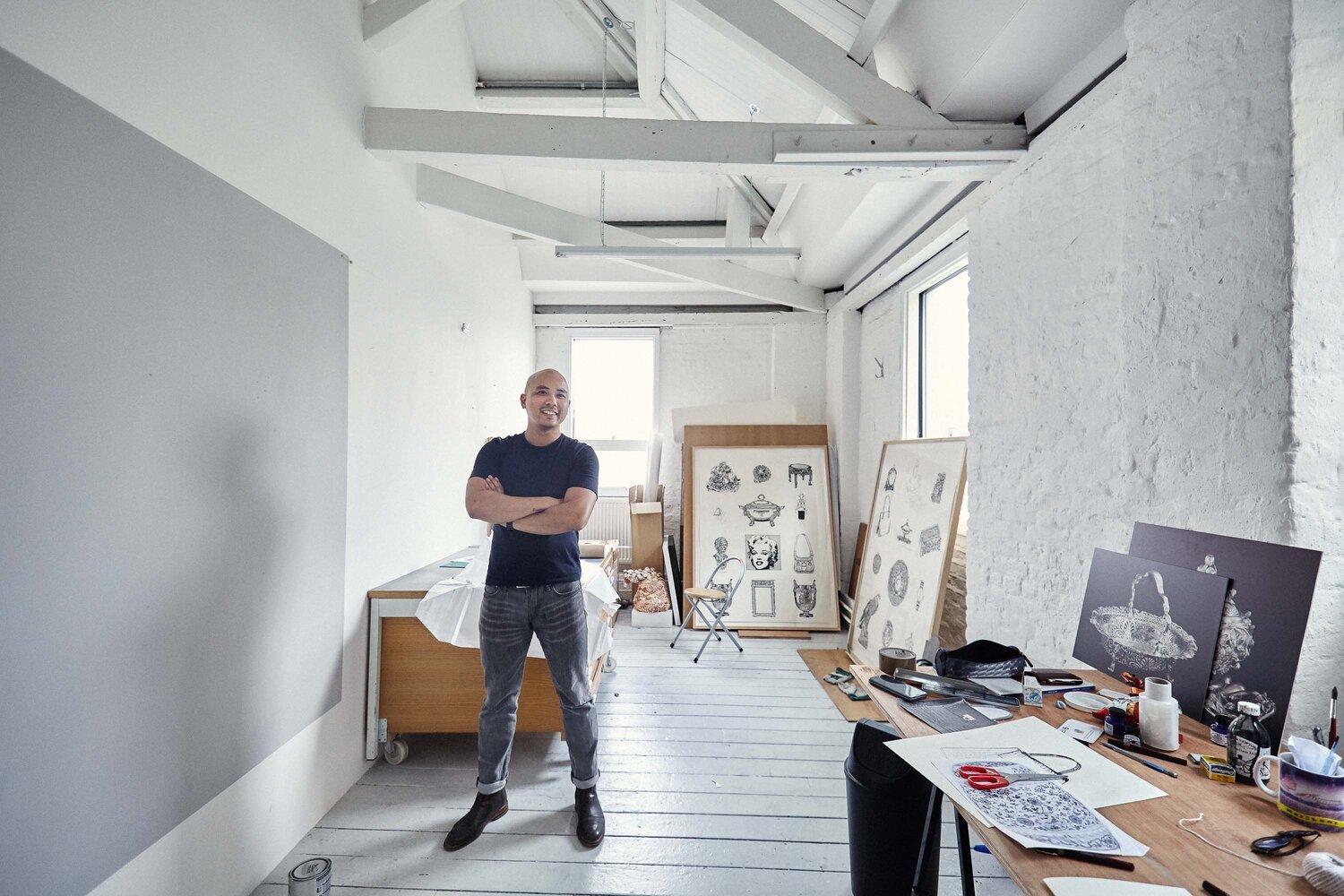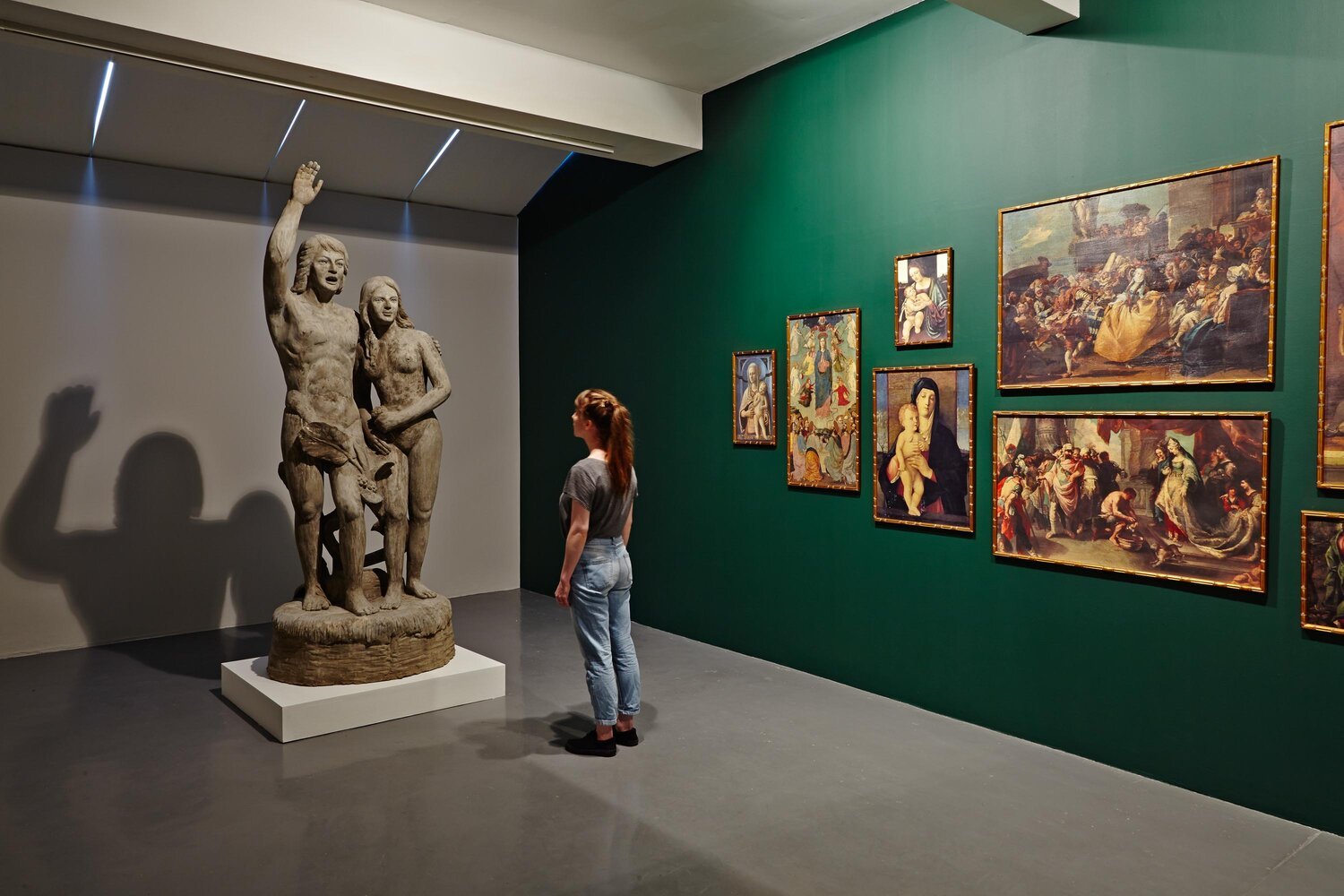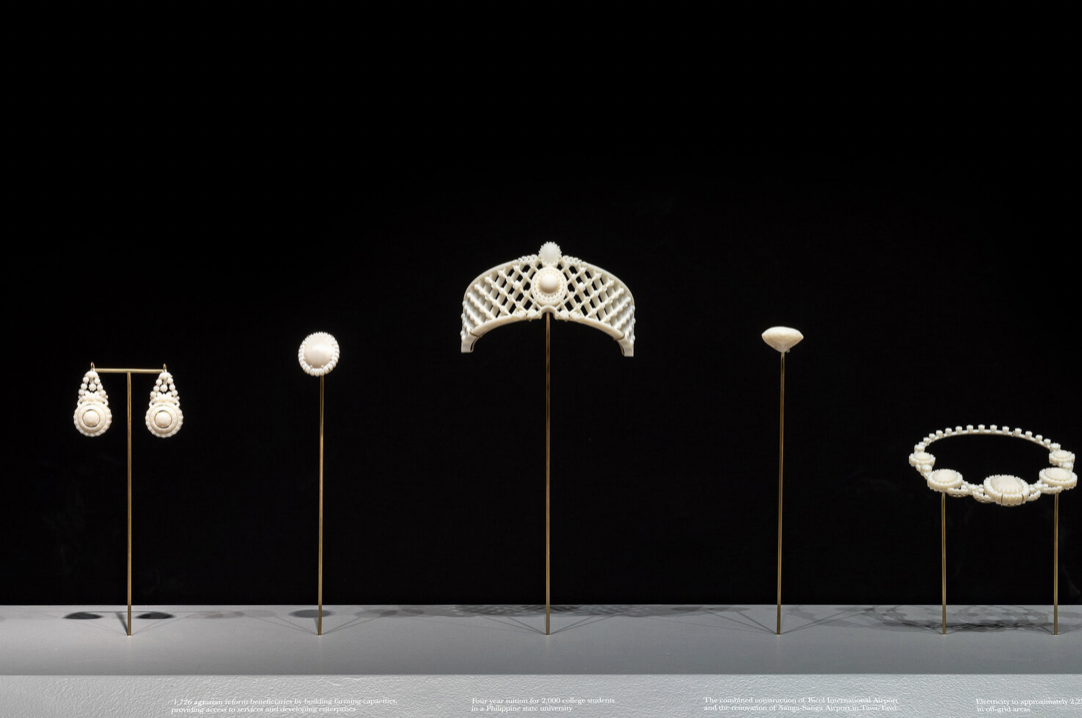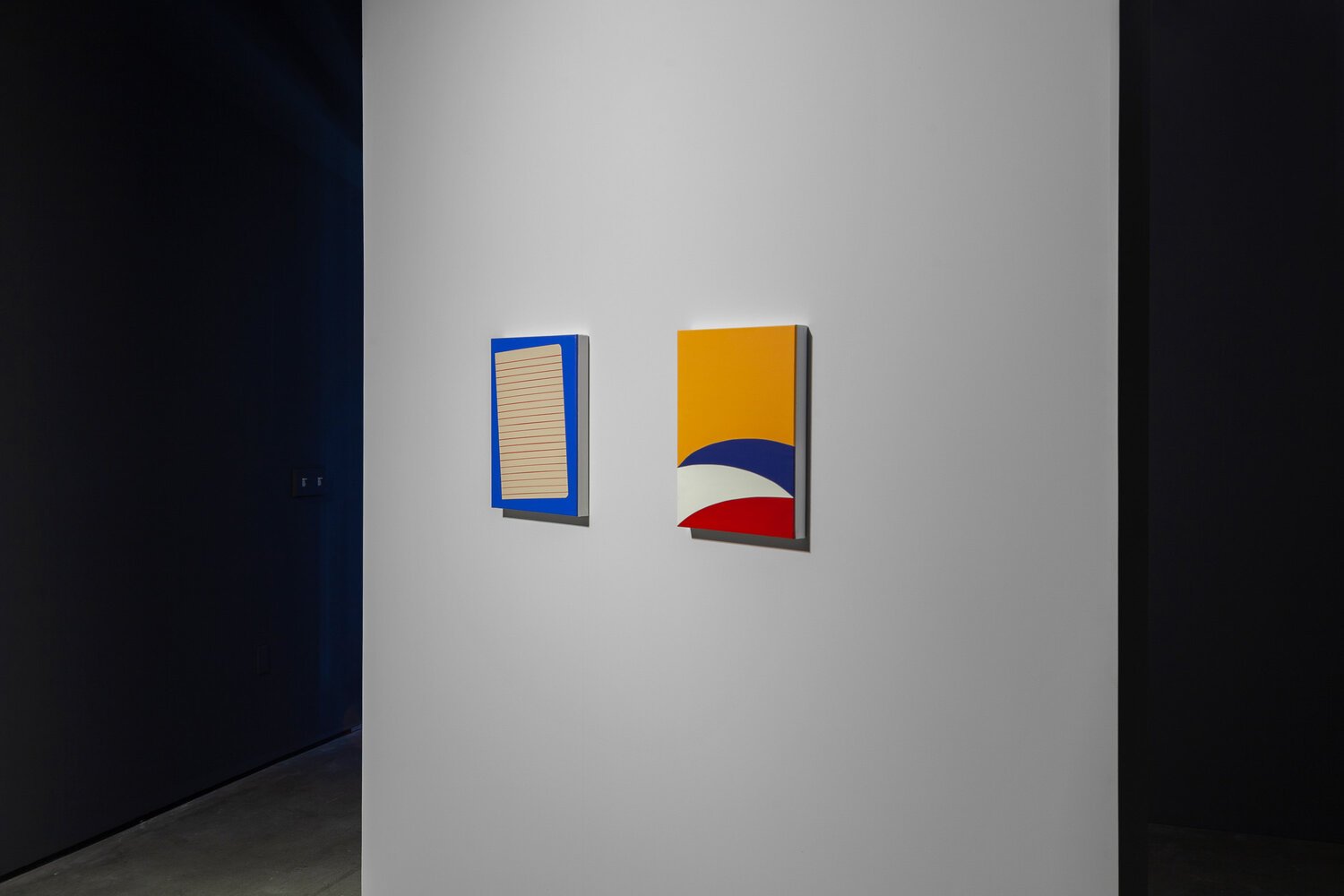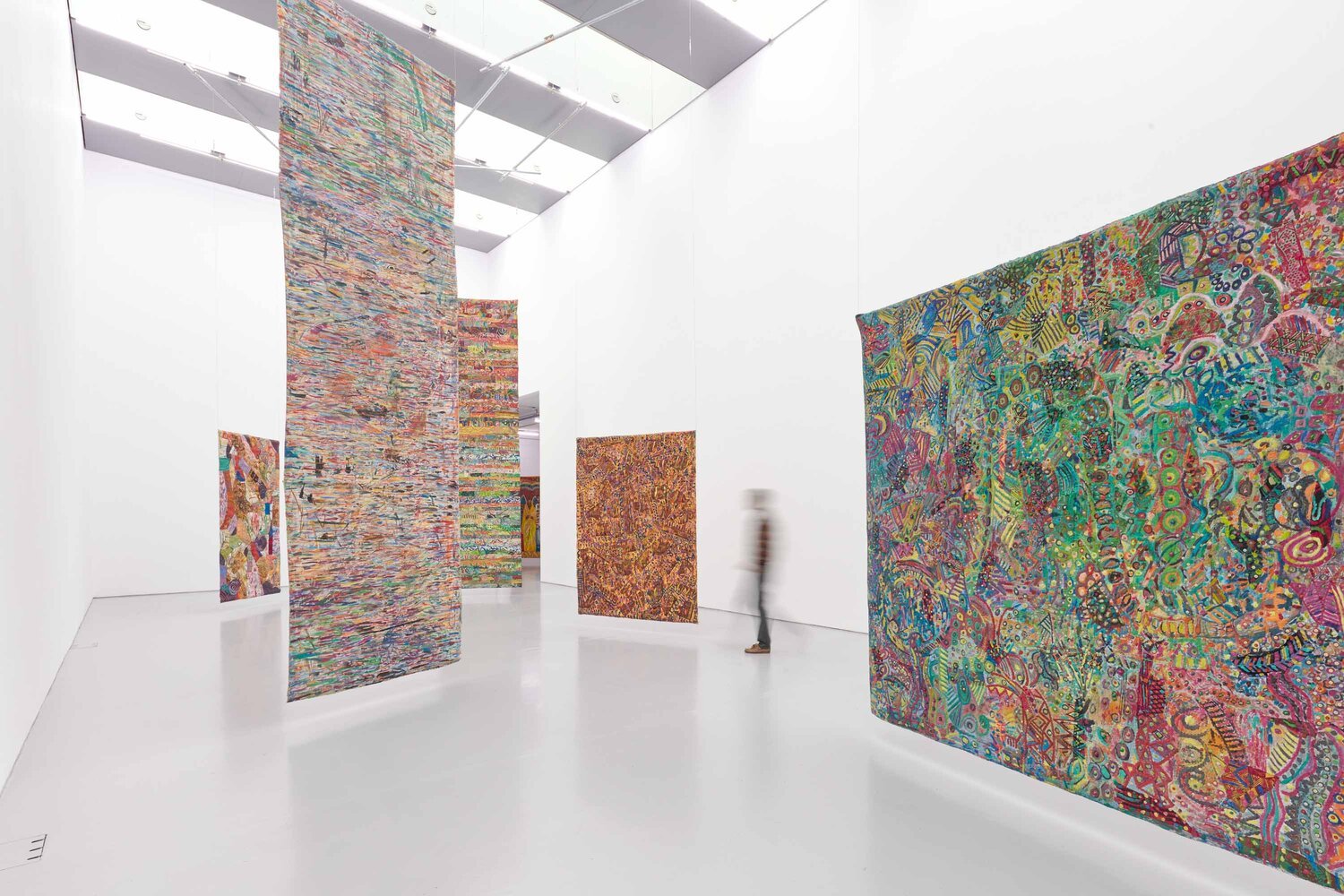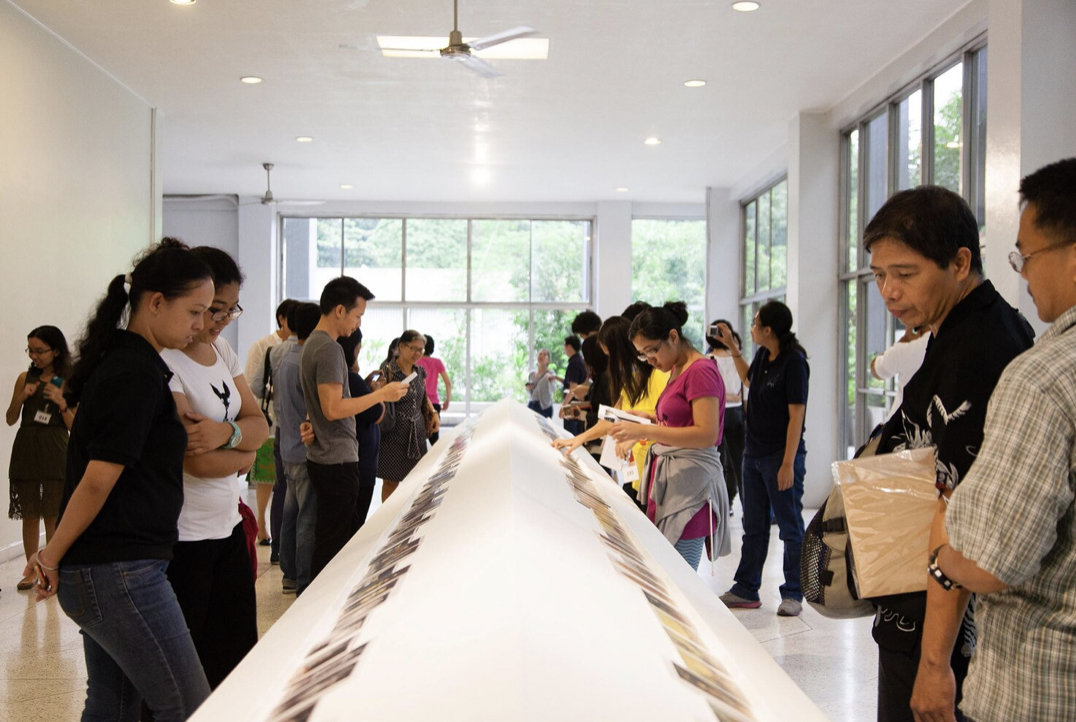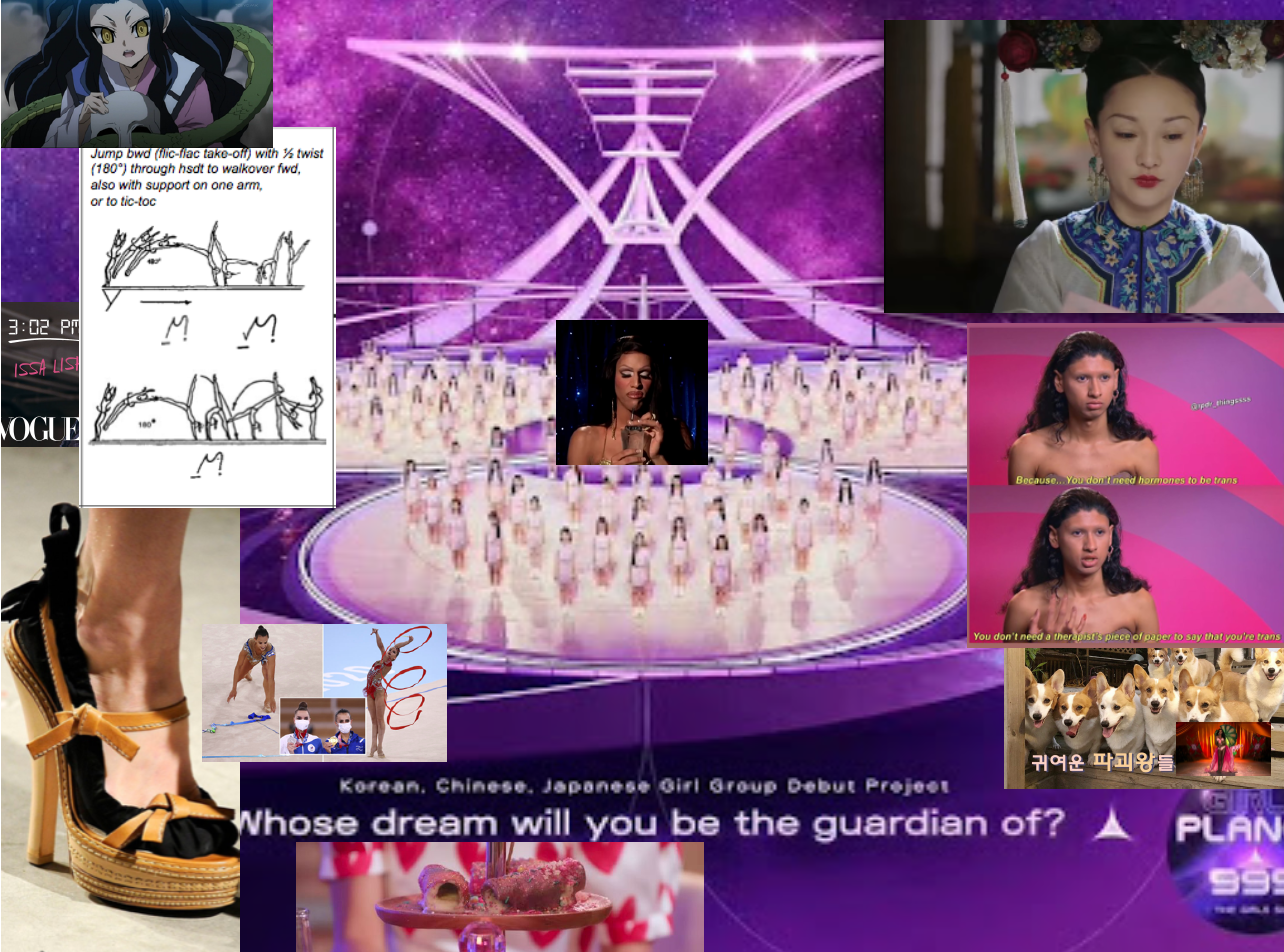Conversation with Pio Abad
Gasworks, KADIST, and Pacita Abad at Spike Island
By Ian Tee
Pio Abad.
Family and politics are running themes in Pio Abad's practice. Born in 1983 in Manila, his parents were political activists involved in the People Power Revolution that led to the end of the Marcos dictatorship. By examining the objects and residues of these political histories, Pio excavates repressed events, unravels official accounts and draws out threads of complicity between ideologies and people. His work manifests in a range of media such as textiles, drawing, installation and photography.
Since graduating from the Royal Academy in 2012, Pio has become a regular fixture in the international art circuit. Selected solo exhibitions include: 'Kiss the Hand You Cannot Bite' (KADIST, San Francisco, 2019), 'Not a Shield, but a weapon' (Art Basel Encounters, Hong Kong, 2017), '1975-2015' (4A Centre for Contemporary Asian Art, Sydney, 2016). His works had also been presented at the Jameel Arts Centre (2019), 2nd Honolulu Biennial (2019), 12th Gwangju Biennial (2018), among others. In 2015, Pio received the prestigious Fernando Zobel Prize for Visual Art, awarded by the Ateneo Art Gallery in Manila.
In this interview, Pio shares his art school experiences, his relationship with London, and the insights he has gleaned from managing the Pacita Abad art estate.
Pio in his Gasworks studio, London. Photo by RJ Fernandez.
I'd like to begin this conservation in 2004, when you left the Philippines for Scotland to study at the Glasgow School of Art. I believe that was your first time in the United Kingdom too, so it must have been a leap of faith. What were your expectations prior to leaving? And how would you describe your education experience in Glasgow and later at the Royal Academy in London?
Moving to Glasgow was certainly a leap into the unknown. It was my aunt, Pacita Abad, who advised that I needed to travel if I wanted to pursue art seriously. Experiences abroad shaped her as an artist and she was instrumental in helping me look through possible options. I think at that time, one of her former assistants had just started her Masters of Fine Arts at Glasgow School of Art and so she told me to look into Scotland, a place I had never been to.
So I arrived in Glasgow, not really knowing anything about the city, apart from the assurance that I would be studying in the iconic Mackintosh building that has since sadly burnt down. I wouldn’t say it was an immediate fit. Adjusting to the weather was not easy and Glasgow is a city that one needs time to truly get to know. It’s not beautiful in the same way that Edinburgh is but I arrived just as the art scene was emerging. It was incredible getting to know the artistic community there and eventually being a part of it. I learned that it was possible to live as an artist from seeing it first-hand through ones whom I still really admire, such as Cathy Wilkes and Simon Starling. I met my wife Frances there too and ended up living there for 5 years, which is funny when I initially thought I couldn’t stay there for more than a month!
I ended up moving to London to pursue my MA at the Royal Academy Schools because it was the only institution that provided free tuition. It had a very conservative reputation when I applied but I couldn’t afford any other options. At that time, fees at the Royal College of Art was £25,000 a year, and I dread to think what it is now.
Again, I think it was coming into a place at a fortuitous moment, when the school itself was undergoing a lot of changes and students coming out of the course were getting a lot of attention. It was quite competitive as there were only 16 students per year, and we all had huge studios in the middle of Piccadilly to experiment and push our practices. The programme was also very student-led and I was in charge of programming artist talks. This meant that you had some say in the conversations you want taking place in the art school.
Pio Abad, 'Some Are Smart Than Others', 2014, installation view at Gasworks, London. Image courtesy of the artist, photo by Matthew Booth.
Currently, you have a studio in South London at Gasworks, a non-profit contemporary arts organisation where you have recently become one of the trustees. Could you share how you connected with Gasworks? And what does being a trustee at the organisation entail?
I think more than anything, it has been my relationship with Gasworks that has shaped my relationship to London as an artist. It has given me a sense of tenure and community in a city that can often be quite a challenging place to call home. I met Robert Leckie, then the curator of Gasworks, shortly before finishing my MA at the Royal Academy and he came for a studio visit as my final show was taking shape. Robert offered me an exhibition a few months later, which was 'Some Are Smarter Than Others', the first iteration of what is now a nine-year project. Interestingly, Robert is the director of Spike Island and we just co-curated the Pacita Abad show that opened in January.
Alessio Antoniolli, the director of Gasworks, invited me to join the organisation as one of their studio artists shortly after my exhibition in 2014. I became a trustee in 2016. We have worked together to start a Gasworks residency for Filipino artists, which is now in its fifth year. Some amazing artists have gone through the programme, such as Martha Atienza, Cocoy Lumbao, Patricia Eustaquio, Cian Dayrit and currently, Mica Cabildo. Gasworks plays an important role in providing artists, particularly from the global South, a platform and a community in London and I am very honoured to play some part in shaping that role.
Pio Abad, '1986-2010', 2012, installation view at the Royal Academy Schools Show, London. Image courtesy of the artist, photo by Andy Keate.
'1986 – 2010' was your graduate thesis presentation at the Royal Academy Schools in London. It brought together a group of ideas and strategies that you've continued developing in the years that followed, such as the printed scarf, ornamental objects and appropriated images. What is the significance of the exhibition title? And could you talk about your thought process behind the choice of works?
Wow, this is really looking way back! The exhibition looks at political narratives surrounding the Marcos dictatorship through a collection of speculative and real artefacts. The title ‘1986 – 2010’ refers to significant years in politics and my family history. 1986 is a nod to the People Power revolution in February 1986 that led to the ouster of the Marcos dictatorship. 2010 was the year when a key object in the exhibition, a seashell clock, was given to my father by Imelda Marcos. They were both members of the Philippine Congress at the time.
The exhibition became a way for me to justify making objects, by filling in the gaps of material history that merely exist as anecdote or rumour. It was also the beginning of me dealing with political narratives related to the Philippines by constructing a collection. One of my favourite objects in that exhibition was a Heinz sandwich spread patterned 'terno', the Philippine national dress that Imelda popularised. This work was based on accounts of protesters who stormed the presidential palace shortly after the Marcoses fled. They found an entire building filled from floor to ceiling with catering-sized jars of Heinz sandwich spread. The idea of protesters finding an unintentional homage to Warhol is obscene and, given Warhol’s affinity for corrupt figures like Farah Diba and Imelda, makes complete sense.
Pio Abad and Frances Wadsworth Jones, 'The Collection of Jane Ryan & William Saunders' (detail), 2019, 24 reconstructions of pieces from the Hawaii Collection, modelled from photographs taken by Christie's, 3D printed plastic, brass and dry-transfer text. Installation view at 'To Make Wrong/Right/Now', Honolulu Biennial, Hawaii. Image courtesy of the artist, photo by Chris Rohrer.
In your artist talk on 'The Collection of Jane Ryan and William Saunders', you said: "Reconstructing the collection has been a defined attempt at achieving some kind of accountability, by using the inventory as a strategy for transparency and resistance." How has this project evolved since its first iteration in 2014? And what are your feelings about the work having to change in response to contemporary politics?
The work has been completely upended by the unravelling of politics since I started my research in 2011, shortly after the death of Muammar Gadaffi. Back then, it seemed that the Marcoses were part of this dying breed of flamboyant despot. We were somehow convinced that we were entering a perpetual phase of liberal democracy, ending impunity and solving racism. Obviously, that is ridiculously naïve now. The Marcoses are no longer historical footnotes —they never were— but a template for the dangerous politicians laying waste to our lives now.
My relationship to the work is constantly changing. There are terrible days when the layers of global bad news make you want to curl up in a dark corner. However, there are days when I feel emboldened to continue on. Given the state of affairs, this project is even more urgent and necessary.
Showing the work in different contexts has been very encouraging. The most recent iteration of the project is collaboration with my wife, Frances Wadsworth Jones, who is a jewellery designer. We have spent the last two years digitally reconstructing the horde of jewellery which Imelda tried to smuggle to Hawaii when they fled, then creating 3D printed replicas of some of the pieces. When we showed the work as part of the Honolulu Biennial, we met a lawyer named Sherry Broder at the opening. Sherry is a human rights lawyer who successfully sued the Marcoses for $2 billion, the largest class action lawsuit in US legal history. The first thing she said was: "I have been looking for these!"
It was incredible seeing the work resonate beyond the realm of art, that it could be a way of performing an act of accountability that so many people continue to fight for amidst the direst of circumstances. It might seem impossible, but perhaps even the act of imagining it can be generative.
Talking about art and the politics of presentation, the Marcos regime was heavily involved in the building of cultural infrastructure and museums. Inevitably, the culture of patronage is tied to power and complicity. You've expressed a desire for 'The Collection of Jane Ryan & William Saunders' to be presented in its entirety the Philippines. How are plans for that coming along? And are there concerns of potential pushback?
Yes, I am planning to bring the entire project back to Manila in 2022. The exhibition will be in the Ateneo Art Gallery at the Ateneo de Manila University. This was where my parents were detained during the dictatorship so, for me, it is important that the project returns to this site.
I wouldn’t be lying if I said I wasn’t concerned. Just last week the government tried to shut down ABS-CBN, the largest broadcaster in the Philippines. Also, given the recent spate of censorship in museums in the region, I will need as much support as I can to bring the works back to Manila and make sure that they stay on display.
Pio Abad, 'For Silme/'For Gene', 2019, acrylic on canvas. Image courtesy of the artist, photo by Jeff Warrin.
'For Silme/ For Gene / For Dina' stood out to me for their austere abstraction and the absence of text. How did these paintings come about and what made you turn to the medium for this project?
I’m glad that those works stood out as I haven’t had the chance to speak about them at length. When I was doing a residency at Kadist in San Francisco, I came across a lot of Marcos-era books and leaflets that were produced as propaganda by the dictatorship. I found the designs really striking. There was this disjunction between the minimalism of form and the baroque violence and corruption brought about by Marcos’ rhetoric.
At the same time as I was researching this propaganda literature, I became really interested in the work of the Filipino American painter Leo Valledor. He was a hard-edged abstract painter who exhibited with Sol Lewitt and Mark di Suvero in New York in the 1960s. Unfortunately, his contributions to that moment in American art history were edited out, largely because he was operating in a white man’s milieu. His works and his life spoke of another kind of violence, and of a different kind of erasure.
With these paintings I wanted to find a way of reclaiming the designs and changing its political meaning, but also pay homage to Valledor’s work. A painting called ‘For M’ is one of the few works he has on display in a museum. It’s at the San Francisco Museum of Modern Art (SFMOMA). I liked this idea of erasing the violence of Marcoses’ words and dedicating the paintings to those who fought against the regime. Silme Domingo and Gene Viernes were Filipino Americans who were assassinated by Marcos goons in Seattle in the 1980s. Dina is my mother, who passed away two years ago. Her illness partly caused by stresses and thanklessness of making positive changes in Philippine politics.
'Pacita Abad: Life in the the Margins', 2020, installation view at Spike Island, United Kingdom. Image courtesy of the Pacita Abad Art Estate and Spike Island, photo by Max McClure.
Most recently, you've co-curated 'Pacita Abad: Life in the Margins' at Spike Island, which is the late artist's first exhibition in the United Kingdom. This follows 'A Million Things to Say' (2018) a major survey of Pacita's work at the Museum of Contemporary Art and Design (MCAD) in Manila, co-curated by you and Joselina Cruz. If the MCAD show was in your words, "a reintroduction", how do the two exhibitions differ? And what do you hope audiences take away from her life and work?
Some of the works from the MCAD exhibition overlap with the Spike Island show, but Robert and I felt very strongly about anchoring the exhibition on her ‘Immigrant Experience’ series. She made them in the early 1990s but these works have only gained urgency over time. 'Life in the Margins' is the first time that the series is shown together nearly in its entirety since they were produced 25 years ago.
It’s been a beautiful experience putting together these exhibitions and bringing her work to a new audience. Even though they were made in response to her time, Pacita's works seem so contemporary. The way these pieces speak about the need for empathy with people who are different from you and how they address politics in a way that isn’t didactic, is much needed in these dire times.
I love watching people take their time looking at the trapuntos. Because of their scale, the multiple narratives and the numerous details, people spend time sitting down in front of the work as though they are watching a film. I rarely see painting being looked at in that way.
'Pacita Abad: A Million Things to Say', 2018, installation view at Museum of Contemporary Art and Design, Manila. Image courtesy of the Pacita Abad Art Estate and MCAD Manila, photo by Pioneer Studios.
Could you talk about Pacita's studio and working method? Did she have temporary working spaces which moved with her as she travelled? Did she employ assistants to help with certain techniques or processes?
Her studio and methods were dictated by her travels. She moved around a lot because of her husband Jack Garrity’s work with the World Bank. The trapuntos are very portable as they roll up easily. Pacita became omnivorous of materials and techniques as she encountered so many different lives and traditions on her journeys. Whenever I visited them, I remember that her studio was the largest room in any place they stayed in. As far as I can recall, she had one or two assistants but most of the sewing was done by her. In the early days, her assistants were my grandmother and my aunt.
In addition to the two exhibitions, you have also been involved in running Pacita's estate for the last few years. With the benefit of hindsight and coming from the perspective of a practicing artist, what are your reflections about her career? Are there any lessons you've learnt that other aspiring artists can benefit from?
Helping run Pacita’s estate has been bittersweet because she is no longer around to witness how the works are being received. It’s ironic that the reasons that Pacita was marginalised as an artist during her lifetime, being a woman of colour and working with techniques and materials associated with craft, are the reasons her work is being celebrated now.
It was interesting that in the same week that the exhibition at Spike Island opened, Faith Ringgold appeared on the cover of Artforum and a Ruth Asawa exhibition opened in London. I think the lesson, or the harsh truth, is just to keep making good work and the audience will find it. It might just not be during your lifetime.
Pio Abad, ‘The Collection of Jane Ryan & William Saunders’, 2014 – ongoing, postcard reproductions of Old Master paintings sequestered from Ferdinand and Imelda Marcos and sold by Christie’s on behalf of the Philippine Commission on Good Government, 97 sets, unlimited copies. Installation view at Jorge B. Vargas Museum. Image courtesy of the artist, photo by Rachel Rillo.
What can viewers expect for your next show 'Things Entangling' at the Museum of Contemporary Art, Tokyo (MOT)?
The exhibition at MOT is in collaboration with KADIST, and it is part of an ongoing conversation I’ve had with them about the ideological lives of objects and narratives of restitution. 'Things Entangling' is a group exhibition and I will be showing large scale photographs as well as the most recent version of my postcard works. The postcards were first exhibited at the Vargas Museum in 2014, and have been shown in a different city every year since.
Are there any future projects you'd like to share?
I will be heading to New Zealand for a research trip to prepare for my first institutional exhibition there. I am also in the midst of planning my first public commission, which will be a permanent artwork in London.
'Pacita Abad: Life in the Margins' is on view at Spike Island, until 5 April 2020.
'Things Entangling' is on show at the Museum of Contemporary Art Tokyo, from 14 March to 14 June 2020.

